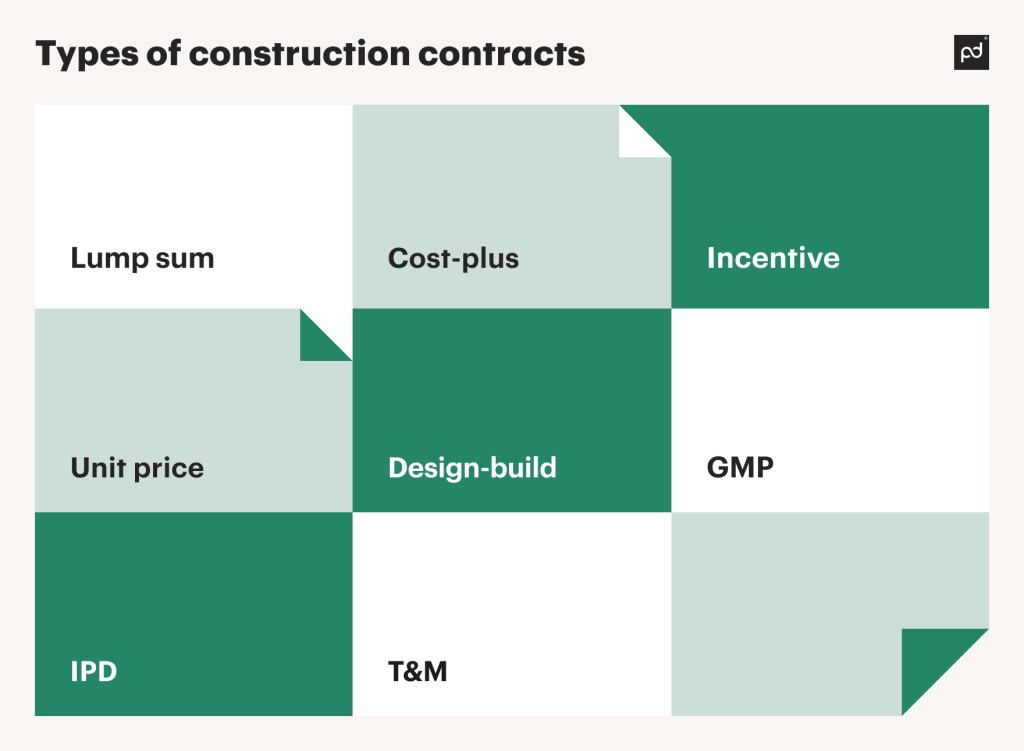Every construction contract starts with an agreement detailing who should work on the project, how much it will cost, and what the contractor should be responsible for.
These contracts legally bind all the signatories to specific tasks, responsibilities, and monetary compensation under the governing law.
In this article, we’ll cover common types of construction contracts to understand how they can help you, as well as the potential drawbacks of every type of contract.

Key takeaways
- Construction contracts vary in terms of pricing model, risk management, responsibilities, and involved stakeholders.
- A fixed-price contract guarantees a specific total price, while an incentive contract provides cost reimbursement for fast delivery.
- Whether you are a property owner or contractor, you must tailor the contract for your construction to your needs, budget, and project requirements.
Lump sum (fixed price) contract
As the name suggests, a lump sum, fixed fee, or fixed price contract stipulates a fixed amount for the entire project.
Under fixed price contracts, both the contractor and the project owner have a clear view of timelines, scopes, milestones, and financial compensation. It also makes it easier for the property or project owner to compare bids.
Lump sum contracts also incentivize contractors to optimize their spending in order to guarantee maximum profit. They are also perfect for works with clear scopes, such as roofing, landscaping, HVAC installation, etc.
Drawbacks of a lump sum (fixed price) contract
Contractors will cut costs and hire subcontractors.
Sometimes, this backfires because cutting construction costs means opting for lower-quality materials or personnel (and no owner wants to hear this news).
For complex projects spanning months or years, choosing a lump sum contract is a massive gamble with the odds stacked against the contractor.
If you’re a contractor, factors like inflation, recession, price fluctuation, or natural disasters can affect your overhead — and your profit, by extension.
Unit price contract
The unit price contract outlines the final cost of every unit of construction.
The base unit could be the price of one facet of the entire project or a fraction of the direct costs of labor or materials.
Unit price contracts are applicable to massive construction works that can be divided into units.
For example, a public housing project can be priced per house, which is the unit of construction.
So if the construction project includes 8 houses, you can get the unit price of just one house.
Drawbacks of a unit price contract
If the initial estimates are lower than the actual costs for the chosen unit, the entire project will go over the budget, which could lead to cost-cutting with disastrous consequences.
Time and materials (T&M) contract
With a time and materials (T&M) contract, the property owner reimburses contractors for hourly labor as well as materials with the agreed-upon markup.
This means that the contractor will get compensated for change orders and delays. As a result, they won’t need to cut costs.
But to prevent contractors from going ballistic with the pricing, the owner can stipulate a not-to-exceed (NTE) clause in the contract.
Drawbacks of a time and materials (T&M) contract
Contractors can exploit the labor loophole in T&M contracts to increase their billable hours.
To avoid paying more than required, the project owner needs to supervise everything closely, which could create disputes and sour relationships with contractors.
On the flip side, the NTE clause could also hamstring the contractor if the total cost of materials and labor increases during the construction process.
Guaranteed maximum price (GMP) contract
When working with a guaranteed maximum price (GMP) contract, the owner places a cap on the amount they are willing to provide for the project. Anything above the GMP comes out of the contractor’s pocket.
The contractor now has to analyze the scope of work meticulously and go over the pricing (and expected profits) before providing an estimate.
GMP contracts are suitable for public works and massive private construction deals.
Drawbacks of a guaranteed maximum price (GMP) contract
One disadvantage of using guaranteed maximum price contracts is that the contractor has to bear the risk of making sure the construction doesn’t go over the initial estimate.
When working with uncooperative owners, contractors might end up in legal disputes in order to get compensation for justifiable cost overruns.
Design-build contract
Going by the name, a design-build contract merges the design and building phases into a seamless construction process.
Often, the owner opts for a design-build contract when working with massive, highly reputable contractors that offer both architectural and civil engineering services.
By combining both the design and building phases, the owner can reduce project costs, prevent inter-company disagreements, and increase delivery speed.
Drawbacks of a design-build contract contract
The cost of a design-build contract could get higher due to a lack of competition. It also places a lot of power in the contractor’s hands.
Cost-plus contract
Under the cost-plus contract, the “cost” refers to the expenses for material, insurance, administration, licenses, labor, etc.
The “plus” is a predetermined fee, which could be a percentage of the overall cost or a set figure.
A cost-plus contract protects both owners and contractors by making room for change orders and cost spikes. It also contains an NTE clause.
Contractors opt for cost-plus contracts when nailing a pinpoint estimate is impossible. They often use them for works with an undefined project scope, such as post-disaster reconstruction.
Drawbacks of a cost-plus contract
The presence of an NTE clause means the contractor would have to pay extra attention to accounting details. They would also have to shave off labor and material costs where possible to maintain the initial profit margin.
Incentive construction contract
When the owner promises monetary compensation to the contractor for finishing the project on time and staying within the budget, this is called an incentive construction contract.
This contract works for time-sensitive projects with a limited budget.
Since the contractor has the incentive to speed up delivery, they’ll put in more effort to choose reliable subcontractors and follow timelines.
The owners can rest assured that the general contractor will complete construction on time — they won’t (shouldn’t) need to resort to cost saving measures for profit.
Drawbacks of an incentive construction contract
Even with the incentive, contractors will still explore loopholes to increase profit. So, owners might need to schedule impromptu monitoring to keep them in check.
Both parties need to define and declare the parameters of completion. This often leads to protracted negotiations.
Integrated project delivery contract
An integrated project delivery (IPD) contract is a tripartite agreement between the owner, builder, and designer under one agreement.
This is a variation of the design-build contract where the designer is a third party.
IPD contracts consolidate the interests, responsibilities, and expertise of all three parties in order to streamline collaboration and guarantee efficient project delivery.
Also, IPD contracts foster accountability since all parties share the risks and rewards fairly.
Drawbacks of an integrated project delivery contract
An agreement between two parties is a contract; add one more party, and it can become an administrative nightmare.
Getting all the stakeholders to agree on a standard operating procedure can be a challenge. This extends to managing risks and sharing rewards.
Also, IPD contracts foster disputes between designers and contractors, especially when they come from disparate construction cultures.
How to choose the right contract for your construction job
As a contractor, the right contract should guarantee you maximum profit with limited changes and risks. As a project owner, you should look for a contract that will guarantee fast project delivery, limited administrative oversight, and budget-friendliness.
Let’s break down the scenarios for different types of construction contracts discussed earlier:
- For projects with a well-defined scope, choose a lump sum contract.
- For construction works with changing scopes, use a cost-plus contract.
- For building projects that need to be delivered fast, choose an incentive contract.
- For projects with an unclear scope, opt for a time and materials agreement.
- For repetitive construction work, use a unit pricing contract.
- For projects with a fixed budget cap, use a guaranteed maximum price contract.
- For construction works that include the design phase, use a design-build contract.
- For any design-build project with multiple signatories, use an integrated project delivery contract.
In some cases, you can combine multiple contracts for different aspects of a massive project.
| Lump sum | Provides a fixed fee upfront | Limits flexibility for contractors |
| Cost-plus | For jobs with a defined scope | Encourages cost-cutting |
| Incentive | Rewards fast project delivery | Agreeing on the incentive takes time |
| Unit price | Splits the entire project into equal units | Mistakes in pricing one unit can affect profits |
| Design-build | One contractor is in charge of design and construction | Gives the contractor too much control |
| GMP | Has a fixed maximum price | Contractors have to monitor costs meticulously |
| IPD | The owner, designer, and builder share one contract | Reaching a consensus on design approaches can be a nightmare |
| T&M | The owner reimburses the contractor for expenses on labor and material | The NTE clause encourages contractors to cut costs |
For instance, when building a house with 5 rooms, you can use a lump sum contract for the entire project.
But when installing HVAC systems in all 5 rooms, you can bill the labor costs per room under the unit pricing model.
Create construction contracts with PandaDoc
Use a contract management solution dedicated to construction docs. Add clauses to templates to speed up the entire drafting, negotiating, and signing process.
Disclaimer
PandaDoc is not a law firm, or a substitute for an attorney or law firm. This page is not intended to and does not provide legal advice. Should you have legal questions on the validity of e-signatures or digital signatures and the enforceability thereof, please consult with an attorney or law firm. Use of PandaDoc services are governed by our Terms of Use and Privacy Policy.


